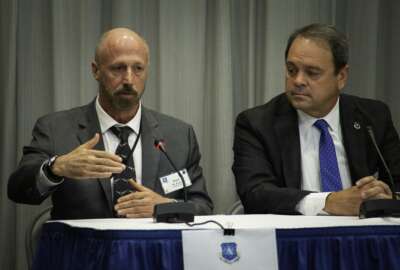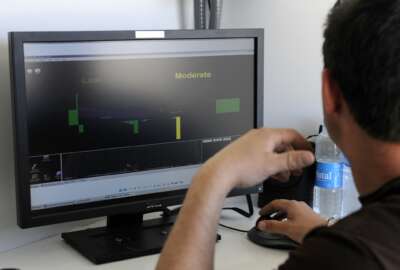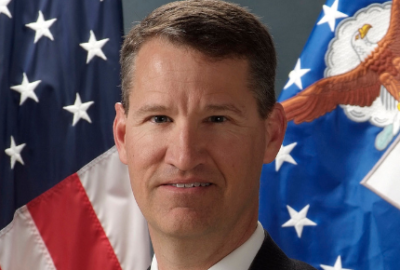
Exclusive
EXCLUSIVE: Air Force touts new digital plan to transform all aspects of the service
The Air Force wants to overhaul its IT infrastructure and focus more on data.
MONTGOMERY, ALABAMA – The Air Force is touting a new digital plan that it thinks will unfetter it from an industrialized way of thinking, open itself to faster networks, better weapons systems and make the service a more attractive employer.
That seems like a lot coming from a plan that is only four pages long (including the title page), but Air Force Secretary Matt Donovan told Federal News Network in an exclusive interview after the Air Force Information Technology & Cyberpower Education and Training Event in Alabama that the strategy is a roadmap to shift the service’s culture and how it operates.
“We’ve been very successful so far with the American military and the individual weapons platforms,” Donovan said. “The problem is these exquisite capabilities are largely unconnected from each other. We need to get to a point where we have a family of systems and everything is connected for command and control. We are ultimately trying to get to a point where any sensor will provide information to any shooter.”
Donovan said it’s a disadvantage, not to mention frustrating, for airmen to work with technology that is slow and outdated. It’s an issue in warfare and it’s an issue for retention when an airmen has to wait 15 minutes for something to load while using Air Force technology, and the same process can be completed by a personal iPhone in just seconds.
“We want to make sure that when they sit down in front of their computer or whatever technology they’re working with that they have the most advanced, cutting edge technology,” Donovan said. “Our airmen who are coming in are digital natives. They have an expectation when they are coming in that their military lives in the Air Force should be comparable to the rest of their lives. We owe it to them so we can optimize their time.”
The digital strategy changes the Air Force’s approach in three ways:
- It will field a 21st century IT infrastructure that is responsive to the demands of combat,
- it will use data for artificial intelligence to help airmen make decisions faster, and
- it will reform its business practices to improve effectiveness and efficiency.
The Air Force has already laid the ground work for the plan by restructuring its chief information office and creating a chief data officer position.
The future of warfare looks something like using a satellite to seamlessly project a real-time stream to an aircraft and a land or sea vehicle simultaneously. Those vehicles are able to talk to each other and their command center, which can send them information saved in a cloud in under a second.
“In the warfare of the future, it starts with a global sensing network,” Air Force Vice Chief of Staff Gen. Stephen Wilson told Federal News Network. “I’ve got to have the communication that connects all those pieces and sensors into this all-domain command and control. I need it in air, land, sea, cyber and space and I need to be able to produce effects en masse that give adversaries dilemmas.”
The Air Force’s infrastructure is not fast enough for seamless information like that, which is why it needs to update its networks. Donovan said wrapping better security and speed around the current infrastructure will cost money.
“It’s going to take some investment to make the initial change,” he said. “One of the challenges that we’ve had, since everything uses IT, is parsing it all out and figuring out where we are actually spending money on it. What we are trying to do is centralize this and capture everything we need. But we do understand it’s going to take some upfront investment, but we are going to achieve some savings later.”
As far as data goes, the Air Force is putting effort into figuring out what to do with all the data it has, how to combine it productively and then use it quickly in a beneficial way.
Air Force Space Command is working on a data strategy. It’s ultimate goal is taking in the large petabytes of information and analyzing them to eliminate the need for some manual processes and advance artificial intelligence and machine learning.
The strategy will also support interactions between machines.
That’s exactly how Donovan and Wilson imagine the data aspect of the new digital plan to work, but on a larger scale.
The strategy comes as defense spending is less likely to continue seeing the increases it has over the past few years.
Donovan said prioritizing the strategy will take some tough choices.
“The other part of that is we really need Congress to authorize and appropriate our defense dollars on time,” Donovan said. “There’s been a lot of talk about a continuing resolution and in my experience one continuing resolution leads to another. When that happens that ends up squeezing all that money to the middle of the year and then we have trouble executing.”
Copyright © 2025 Federal News Network. All rights reserved. This website is not intended for users located within the European Economic Area.
Scott Maucione is a defense reporter for Federal News Network and reports on human capital, workforce and the Defense Department at-large.
Follow @smaucioneWFED
Related Stories





